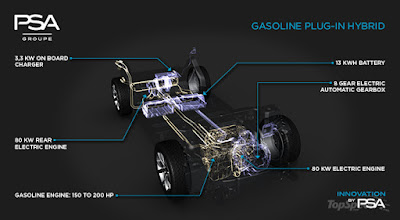PSA Group unveiled their electrification strategy plans at the “Innovation Day” event. PSA Group is consolidating the development of its new electrification strategy on two global modular platforms, which will allow it to offer a wide range of internal combustion, electric and plug-in hybrid petrol models as from 2019. Both platforms will be compatible with the manufacturing resources put in place as part of the Plant of the Future programme.
The Common Modular Platform (CMP), which was developed in partnership with DFM (Dongfeng Motors), is dedicated to compact city cars, core sedans and compact SUVs. The all-electric e-CMP format co-financed by PSA Group and DFM will allow the two parties to offer a new generation of spacious, multi-purpose electric vehicles with a driving range of up to 450 km and ultra-fast charging solutions providing up to 12 km of driving per minute of charging. Four electric models will be introduced by 2021, the first of which will reach the market in 2019.
The Efficient Modular Platform (EMP2), which is dedicated to compact and premium models, was launched first in 2013 with the new Citroën C4 Picasso and Peugeot 308 and then in 2014 in China. From 2019 onwards, its innovative design will enable the deployment of the first plug-in hybrid petrol models equipped with the best of hybrid technology:
To facilitate use, the plug-in hybrid models will come with a four-hour charging system as well as an optional feature for recharging the battery more quickly, in less than two hours. Seven plug-in hybrid vehicles will be gradually introduced between 2019 and 2021.
On Innovation Day, Gilles Le Borgne said: "These next-generation hybrid and electric technologies will complement our range of internal combustion engines, thereby enabling PSA Group to offer its customers a diversified line-up of technologies that meet all of their mobility needs. This innovative strategy clearly demonstrates the Group's commitment to global, sustainable solutions that will allow us to take on the energy transition challenge."




